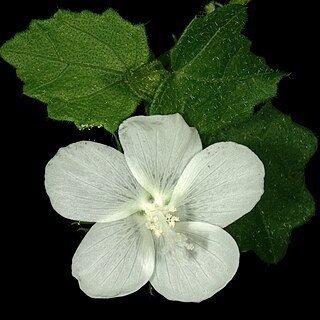Leaf-lamina 1–6 × 0·5–4 cm., usually ± ovate, sometimes hastate-triangular, somewhat angular or subtrilobed, apex usually acute, margin irregularly and coarsely serrate or crenate to lobulate or occasionally almost entire, base rounded to subcordate, upper surface usually dark green drying brown and usually sparsely and somewhat harshly stellate-pubescent to almost glabrous, lower surface usually more densely stellate-pubescent to tomentose with a whitish or greyish indumentum and hence usually discolorous; petiole up to c. 6 cm. long, hairy like the stems; stipules 2–4 mm. long, setaceous, caducous.
Erect or low-spreading suffrutex, 20–90 cm. tall, often branched from the base; stems slender, terete, yellowish-or brownish-hirtellous-stellate-pubescent to stellate-tomentose when young, sometimes with long stellate or simple patent hairs and sometimes also ± glandular-viscid, glabrescent, ultimately woody and covered with a greyish to pale-reddish-brown finely longitudinally marked bark.
Erect or low-spreading shrub, 0.2-0.9 m high. Leaves ovate, 3-lobed or subhastate, coarsely and irregularly serrate or dentate, discolorous. Epicalyx 9-11 bracts, 9-12 mm long, much longer than calyx. Mericarps not toothed on lateral angles. Flowers white.
Calyx 5–7 mm. long, subcampanulate, membranous, scarious-papyraceous in fruit, stellate-setulose to almost glabrous, divided beyond the middle; lobes 1·5–2·5 mm. broad near the base, acute or acuminate.
Mericarps 3–4 mm. long, triquetrous, ± keeled dorsally and with 3 weak transverse ridges, not winged, glabrous or finely stellate-pubescent mainly near the apex.
Flowers axillary, solitary, mostly towards the tips of branches and twigs; pedicels up to 4 cm. long, articulated in the upper 7 mm.
Seeds 2–3 mm. long, ovoid-triquetrous, brown, sparsely to densely pubescent with very small yellowish or brownish hairs.
Epicalyx of 9–11 bracts; bracts 9–12 mm. long, nearly free, filamentous-setaceous or narrowly linear, hispid-setose.
Staminal tube glabrous or with small tufts of hairs at the line of fusion with the petals.
Petals c. 16–18 mm. long, stellate-pubescent on the outside.

